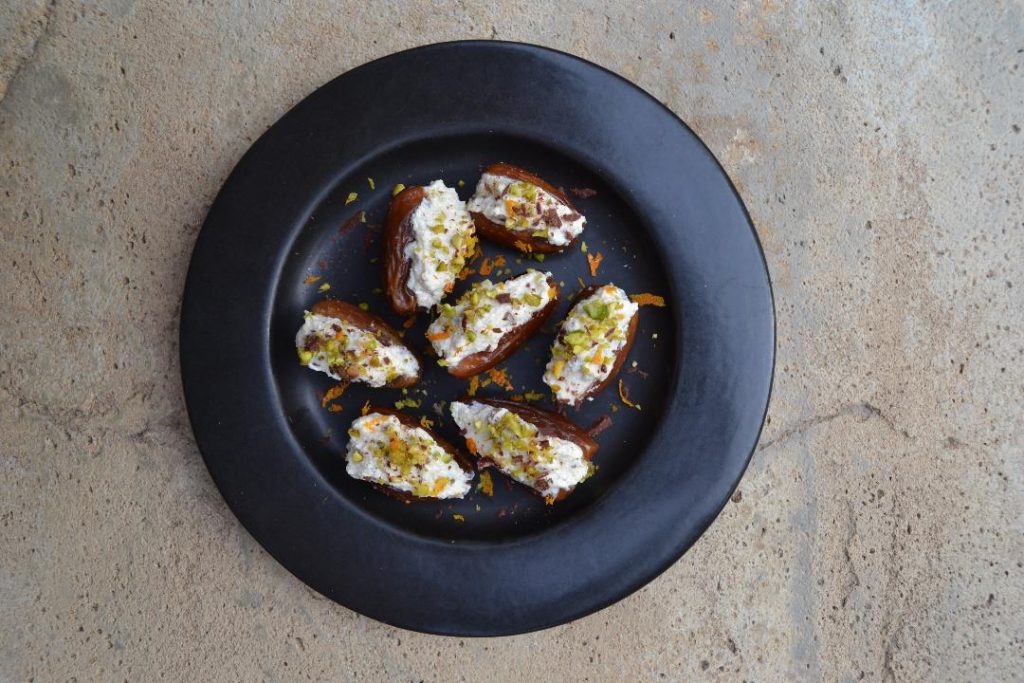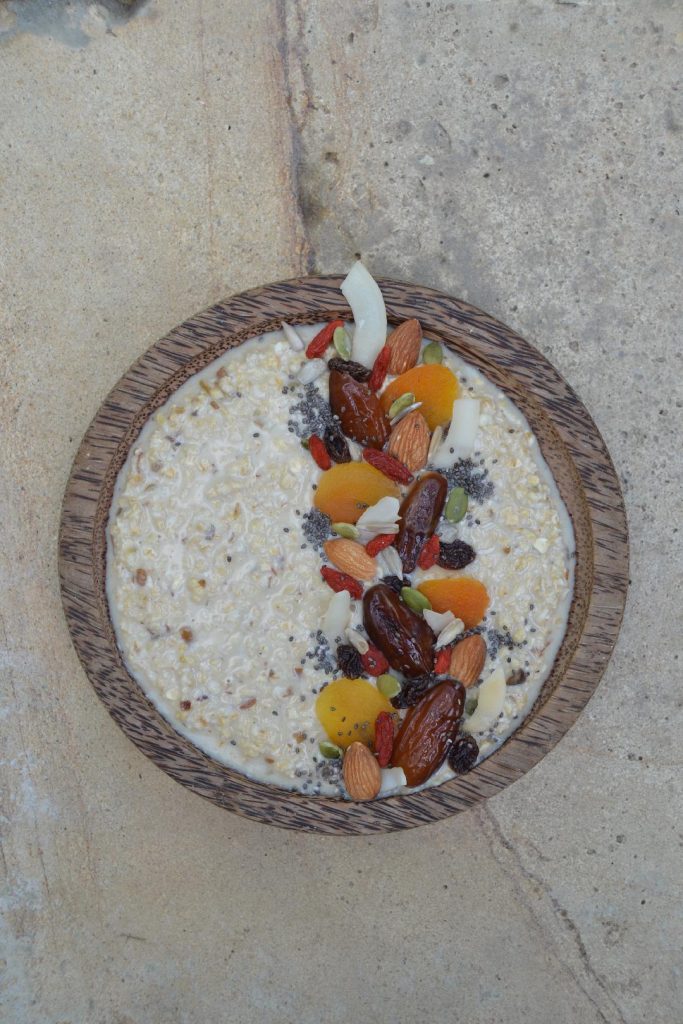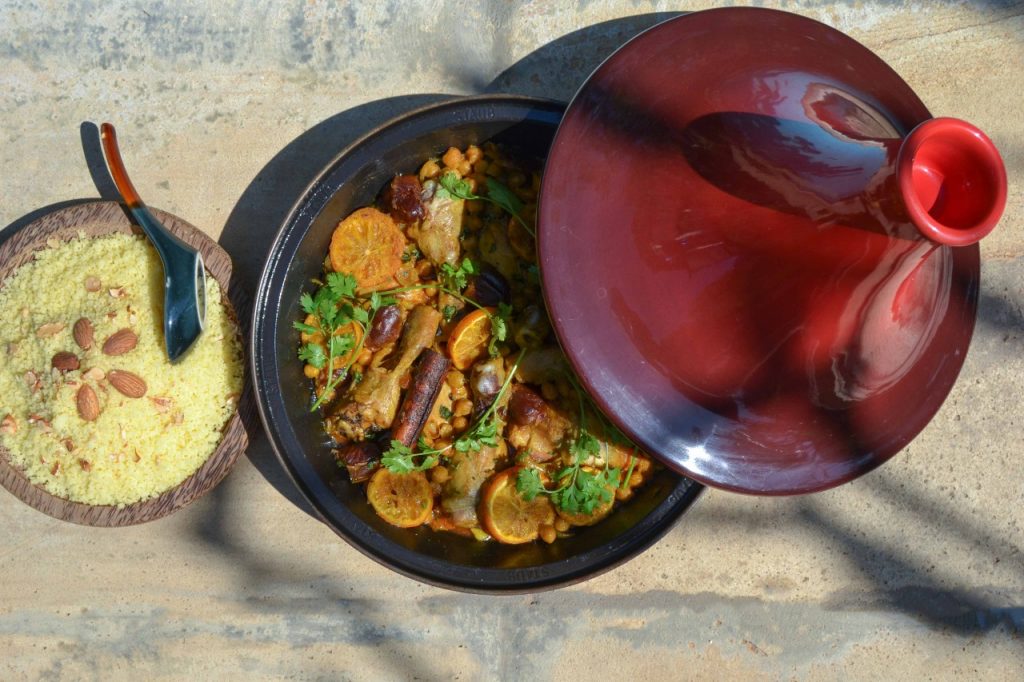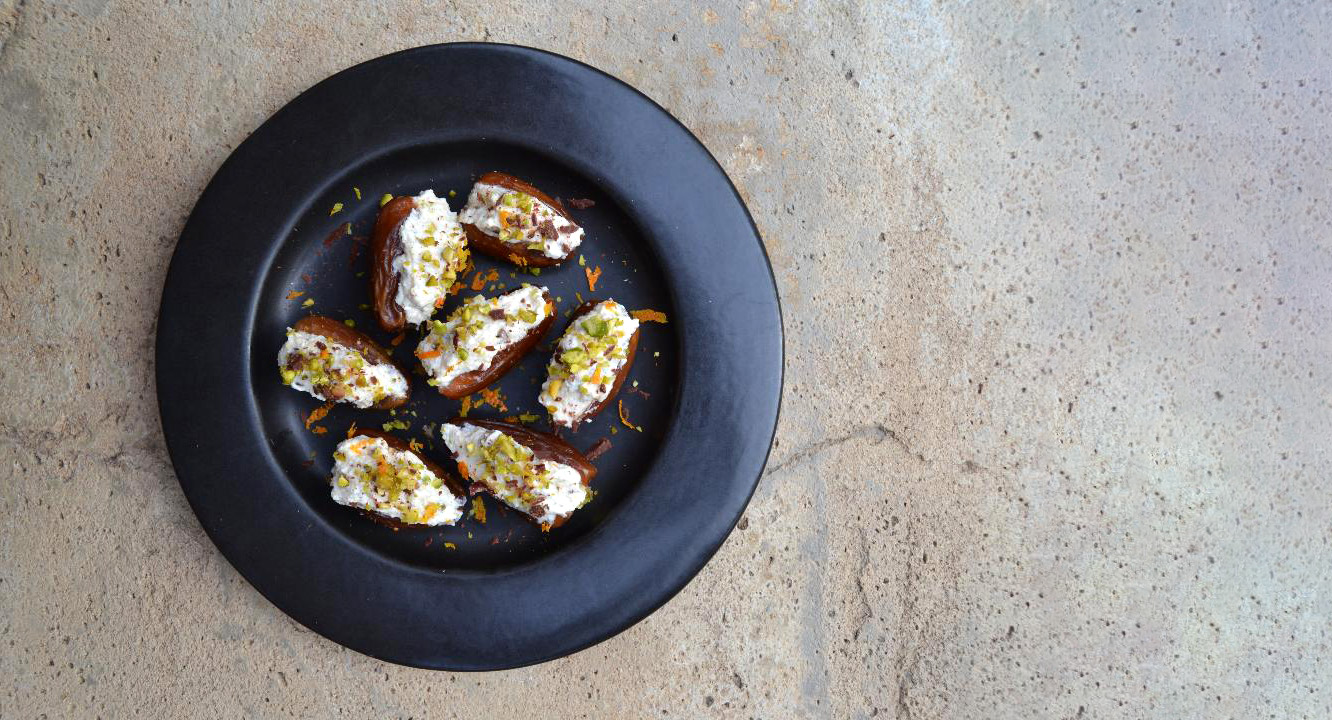We’re in Ramadan month where Muslims from all over the world, including in Indonesia, are fasting from sunrise to sunset and this means, during this period, dates are found abundantly throughout the Country – from humble food stalls, supermarkets to luxurious gourmet stores. Dates have been the staple for takjil (opening) treat, when the sun finally sets, then followed by the iftar meal, to nourish the bodies after a day of fasting.
Dates are an ideal and healthy choice for this purpose as they’re high in sugar, fibre and minerals. They’re also rich in iron, potassium, magnesium with also a bit of fat and protein. They’re easy to digest and are a quick source of energy and nutrients – this explains why the energy bars we find in the health food stores have dates as the principal ingredient!
Dates have low GI (Glycemic Index), around 45 to 55, depending on the variety. This means that they will be metabolised slowly by our bodies during the day, keeping us feeling full and energised longer. When we eat dates on empty stomach, it helps our blood glucose levels to return to normal quickly, hence, gratify us with the sense of satiety and prevent us from overeating – which happens if our bodies are craving for sugar.
Here I’m going to give you three ideas on how to use the omnipresent dates and include them in your meals during the fasting month, from sahoor at dawn to the iftar at dusk. But, mind you, although the fructose found in them is ‘good’, it’s still sugar. So, no, unless you’re training hard to run a marathon, you can’t eat 500 grams of dates in one day!
Stuffed Dates with Ricotta, Orange, Pistachio and Chocolate
I thought you might grow bored of eating plain dates for takjil, I would if I were you! So I thought of making this sweet treat, inspired by Moroccan-style stuffed dates – usually with almond paste, dried fruit and, sometimes, cream cheese. While, in this case, for the filling, I used the Italian flavoured ricotta cheese cream, we normally use to fill cannoli – Sicilian cylinder-shaped fried pastries (which I love more than the Tiramisù!). Serve with some hot fresh mint teas for some Middle Eastern feel.
(makes 20 pieces)
20 dates
150 g ricotta cheese
20 g icing sugar
20 g (2 tbsp) milk
1 g (a pinch) cinnamon powder
A pinch of salt
1 bitter orange or lemon (only zest)
15 g chopped dark chocolate (75%)
10 g chopped pistachio nuts
- Smoothen the ricotta cheese by pressing and passing it through a fine sieve placed over a bowl.
- Add icing sugar, cinnamon powder, salt and milk. Mix to a creamy spreadable consistency.
- Incorporate the orange zest, 10 grams of the chocolate and half of the pistachio into the cream.
- Cut open dates on one side without halving them and remove the pits.
- Slightly open pitted dates like books and fill each one with about 1 teaspoon of the ricotta cream.
- Arrange them on a serving plate, sprinkle with the remaining chocolate, pistachio and extra-fine grating of the orange zest.
- These stuffed dates keep well in the refrigerator for a couple of days, if stored correctly in a container with a lid.

Overnight Oats with Dates, Dried Fruits and Seeds
(serves 2)
When fasting it’s important to have suhoor meals containing lots of fibre and to drink plenty of water to help you feel full and hydrated during the day. It’s also best to consume food with a low glycemic index that releases sugar slowly and gradually, to allow you to feel energized longer. This overnight oat are my to-go breakfast when I know I’ll have a busy long day ahead and I’m not sure when or if I’ll be having lunch. It’s really a no-brainer to make, I’m not even sure if I can call this a recipe! There’s no cooking involved – just some pouring, stirring and a little chopping. You don’t even have to know how to cook to prepare them! The best part is that they take a few minutes to whip up, store them in the refrigerator and let the magic work while you sleep! I used almond milk this time around, but it can be substituted with any other type of milk you prefer. This the basic proportion between oats and the milk. Afterwards, just let your fantasy run wild and experiment by adding extra flavours or spices into the oats and choose any “topping” you like. In keeping with the Ramadan theme, here I used dates, dried fruits and seeds, but feel free to add seasonal fruit instead!
A little bit about oats; they’re naturally rich in fibre, low in calories and sugar, hence they keep you feeling full longer. No wonder this grain has been a breakfast staple in many countries for generations! The beta-glucans in oats also help to stabilise the blood sugar, lower the bad cholesterol level and boost the defences of the immune system. Moreover, many types of research found that antioxidants in oats called avenanthramides also reduce the risk of cardiovascular diseases. I like oats because they taste good but, after reading all these studies, I’m surely going to eat more of them!
Overnight oats:
100 g rolled oats
300 g almond (or soy) milk
30 g (3 tbsp) honey
20 g (2 pieces) pitted dates
Toppings:
60 g (6 pieces) pitted dates
30 g (4 pieces) dried apricots
5 g dried coconut flakes
10 g almonds
5 g (1 tsp) raisins
5 g (1 tsp) goji berries
5 g (1 tsp) sunflower seeds
5 g (1 tsp) pumpkin seeds
5 g (1 tsp) chia seeds
- Place oats in a jar or any container. Pour in the almond milk and honey. Add pitted and finely chopped dates.
- Stir to mix the ingredients evenly. Cover jar with the tap and store in the refrigerator overnight (hence, the name), about 5 to 8 hours.
- The next morning, you’ll find that the oats have thickened and assumed a “porridgy” like consistency – without actually cooking it.
- Transfer into a serving bowl and top with the dates, dried fruits and seeds. The more the merrier!

Moroccan Chicken, Bitter Orange and Dates Tagine
Tagine is actually earthen cookware originally from Morocco with a unique cone-shaped lid. It’s mainly used to braise and stew meat and/or vegetables so, the dishes cooked using this pot are called also tagines – an equivalent of Asian curries, I’d say. The shape of the cone allows steam to remain inside the pot, hence, less water is needed compare to cooking stews and curries with a regular pot.
Tagines are traditionally used over the wood fire but, nowadays, it’s also possible to cook with them over the stovetop by using a diffuser, to prevent the fire from touching the bottom of the pot directly. Because of its pretty shape, it’s often used also directly as the serving dish and put in the centre of the table. Lately, it’s also possible to find a more resistant and modern tagine made of the cast-iron bottom.
In tagine stews, you can basically use whatever ingredients you wish. This one is inspired by a Moroccan Lamb and dates tagine, but I substitute it with the more accessible chicken. The bitter oranges are my addition as we’ve just harvested them here, in Padma Ubud’s Agroforestry and I find that poultries and citrus fruits go really well together. Regular oranges or lemons are good alternatives.
If you don’t have a tagine at home, you can cook this recipe in a heavy-bottomed cast-iron or stainless steel pot with a lid.
(serves 5)
5 whole chicken thighs
3-4 bitter oranges, sliced into rounds
10 dates, pitted and halved
100 g cooked chickpeas
2 onions, sliced to strips (julienne)
3 cloves of garlic, chopped
25 g fresh ginger, grated
5 g (1 piece) cinnamon stick
3 cardamom pods
5 cloves
4 g (1 tsp) turmeric powder
4 g (1 tsp) coriander powder
4 g (1 tsp) paprika powder
1 g (a pinch) black pepper
5 g fresh coriander leaves
400-500 ml vegetable stock or water
30 g (3 tbsp) extra virgin olive oil
Salt, to taste
Accompaniment:
250 g couscous
250 g hot vegetable stock or water
50 g (5 tbsp) extra virgin olive oil
Salt, to taste
- Heat oil in the tagine. Add cinnamon and the spices, stir for about a minute until fragrant. Include the onions, garlic and ginger and sweat, with the addition of a touch of water, until the onions are translucent.
- Insert the chicken thighs and cover all of it surfaces with the spices. Add salt and arrange the chicken nicely in the pot.
- Pour the stock or water. Scatter the orange slices and the dates evenly around the chicken.
- Cover with lid and simmer over medium heat for about 20 minutes.
- At this point, include chickpeas and add a bit more stock if the tagine seems to be drying too much. It shouldn’t be too watery but not dry either.
- Braised for further 10 minutes or so, depending on the size of your chicken thighs, until the chicken is thoroughly cooked.
- Serve warm with couscous, or rice if you prefer.
For the couscous:
- Place couscous in a large bowl. Add salt and oil and incorporate it into the couscous until all the grains seem to be covered by oil.
- Pour in the hot water or stock. Give it a quick mix and cover the bowl with lid, cling film or a large plate – whatever is handy for you. Rest for 10 to 15 minutes.
- After the resting time has passed, you’ll see that it has doubled in volume. Fluff up the grains using a fork and serve with the tagine stew.

Author:
Theodora Hurustiati
Head Chef of Padma Resort Ubud


No comments